

Assemblymember Rhodesia Ransom’s AB 13 Aims to Lower California’s High Electricity Costs
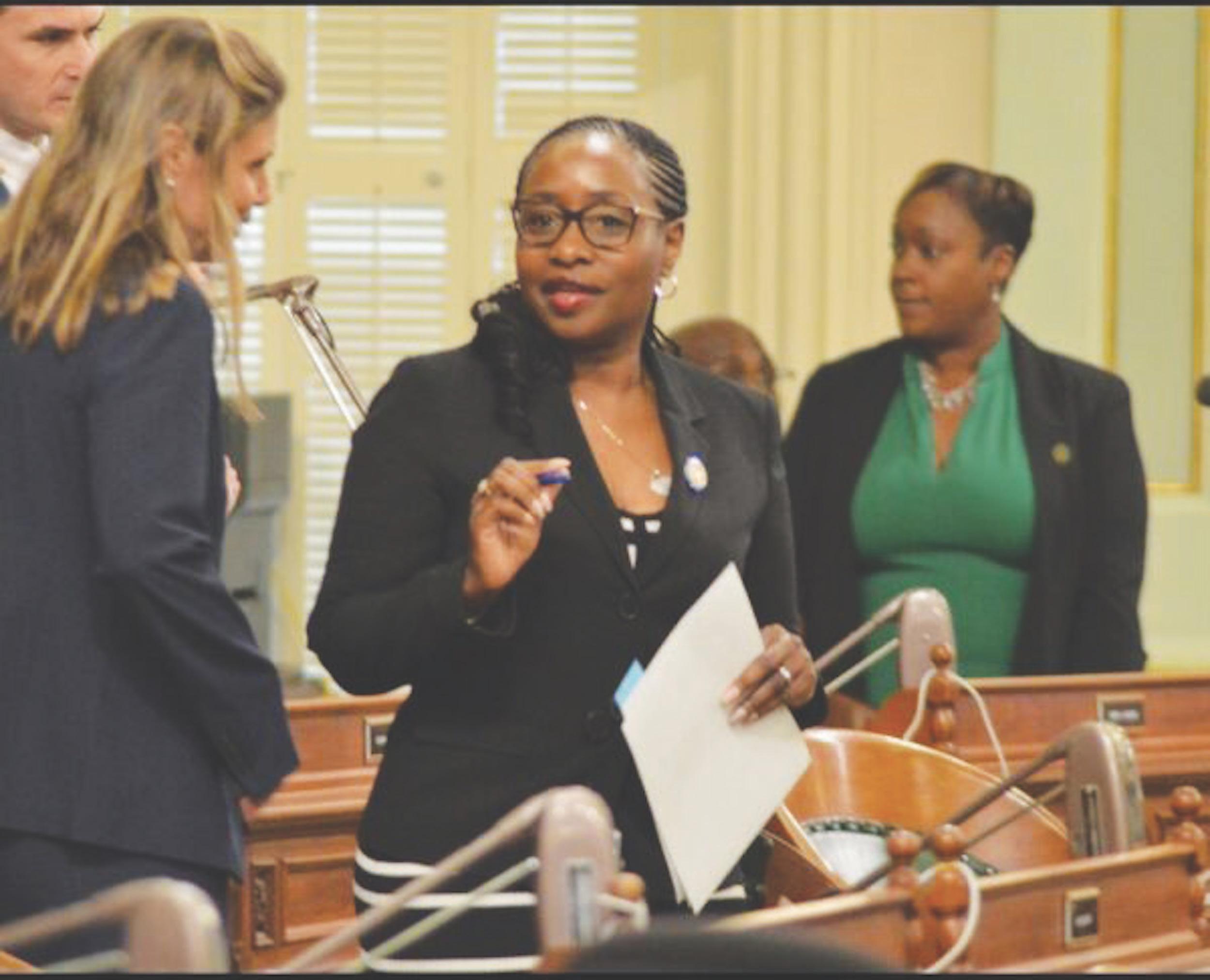
AB 13, if passed, would reform the California Public Utility Commission to increase its accountability to taxpayers. CBM photo by Antonio Ray Harvey.
Assemblymember Rhodesia Ransom (D-Stockton) says she understood before she was elected to office last year that Californians pay among the highest electricity rates in the country. So, lowering that cost – and that of other utility bills — has become her top priority.
A member of the California Legislative Black Caucus (CLBC), Ransom, on her first day on the job in December, introduced Assembly Bill (AB 13). If passed, the legislation will reform the five-member California Public Utilities Commission (CPUC) and hold its regulators more accountable, providing residents with the transparency, she says, they deserve regarding how their bills are increased.
“This is necessary because (CPUC) oversees the utilities companies that request rate hikes,” Ransom told California Black Media (CBM). “So far, that has been happening but we as the public don’t understand that the CPUC is not an elected body. It is an appointed body. They don’t have to answer to constituents who hold them accountable.”
Ransom represents California’s 13th Assembly District, which includes the communities of Stockton, Tracy and Mountain House. A former Tracy City Councilmember, Ransom was elected to office in the November
General Election and is one of nine Black women legislators that are part of the 12-member CLBC.
“We need to ensure that decisions affecting utilities are made with fairness, transparency, and accountability, prioritizing affordability for Californians,” she stated.
The CPUC is a state regulatory agency that was created by a constitutional amendment to regulate privately owned telecommunications, electric, natural gas, water, railroad, rail transit, passenger transportation, and in-state moving companies.
The CPUC is responsible for ensuring that California utility customers have dependable utility service at less expensive rates, protecting utility customers from acts of deception, and promoting the well-being of California’s economy. The agency has a staff of approximately 940 employees.
The commission’s board, which typically meets twice a month, is comprised of five members with a president. Board members are appointed by the Governor and serve six-year terms. The current commissioners are Alice Busching Reynolds, Darcie L. Houck, John Reynolds, Karen Douglas, and Matthew Baker. Busching-Reynolds is the President.
AB 13 would require that four members of the commission represent the geographic locations of the four State Board
of Equalization districts. The bill would require that one member be an at-large member with unspecified qualifications.
“We all wonder sometimes how they make their decisions, how they are approving these rates and are they putting people first,”
Ransom said. “They are a part of the California Constitution. They are appointed by the Governor. The Constitution does say they are supposed to be accountable to the Legislature, but the Governor gets to appoint them.”
Ransom continued, “So far, the legislature does not play a big role in what they do. We do get reports from them, but we should be getting a little bit more.”
Additionally, AB 13 would prohibit an elected member of, or an employee of, the Legislature or an employee of the executive branch from serving as a member of the commission within one year after leaving the position as an elected member or employee.
Ransom said she has been working in earnest with stakeholders and her legislative colleagues for months to make sure the bill is a pathway for workable policies that will result in “accountability, accessibility, and transparency” to avoid the rate increases that have constrained many consumers.
AB 13 has been referred to the Assembly Committee on Utilities and Energy, where amendments will be made to further align the
bill with its intended goals.
The introduction of AB 13 came six weeks after Gov. Gavin Newsom signed an executive order designed to reduce electric costs for Californians. The CPUC and California Energy Commission (CEC) were tasked to examine ways to trim programs that would save money on electric bills.
The Governor’s action aimed to provide electric bill relief while maintaining the state’s commitment to achieving carbon neutrality and 100% clean electricity by the year 2045.
Last year, millions of state residents received an average credit of $71 on their October electric bills from the California Climate Credit, provided by the state’s Cap-and-Trade program.
The climate credit provides ratepayers with their share of the benefits of California’s Capand-Trade Program, according to CPUC. The credits are issued twice a year – a natural gas credit in April and electric credits in April and October.
“We’re taking action to address rising electricity costs and save consumers money on their bills,” Newsom stated on Oct. 30. “California is proving that we can address affordability concerns as we continue our world-leading efforts to combat the climate crisis.
On Feb. 18, CPUC released a document titled “Response to Executive Order N-5-24,” a 38page document that recommends examining the benefits and costs to electric ratepayers, taking action to modify or sunset any underperforming or underutilized programs, and consulting with the Office of Energy Infrastructure Safety on adjustments to utility wildfire safety oversight processes, procedures, and practices.
Assembly Minority Leader James Gallagher (R-Yuba City) discounted the report, calling it “useless.” However, he said the document confirmed that there is another problem.
“A newly released report shows there is plenty of waste in our electricity rates that has never been reviewed for costeffectiveness,” Gallagher posted Feb. 19 on X. “Mandates and subsidies make our rates some of the highest in the nation. Enough.”
Ransom said working Californians cannot afford another rate hike or price increase.
“We just want to make sure that people in the position can look out for our best interests,” Ransom told CBM.
California vs Trump: Attorney Gen. Bonta Lays Out “Resistance” Plan
Antonio Ray Harvey | California Black Media
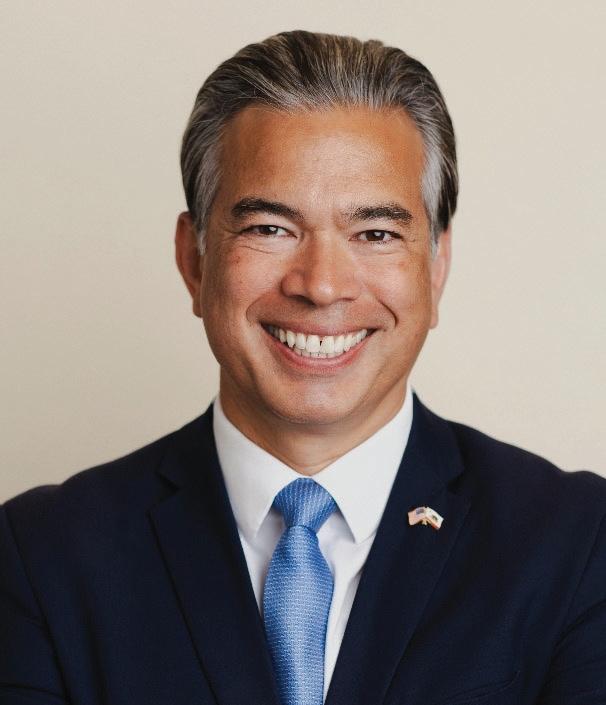
During an online conference on Feb. 26, California Attorney General Rob Bonta detailed how the Trump Administration had used its firstfive and half weeks to execute an agenda that runs counter in various ways to California state policies and priorities.
Since taking office, President Donald Trump has issued scores of executive actions that make good on many of his campaign promises. Bonta said the impact of Trump’s exercise of his powers is creeping up on the doorsteps of California’s diverse residents.
“People are scared, worried, anxious, and uncertain about what’s happening in the federal government. And will it impact their lives and loved ones,” Bonta said. “Sadly, I think it’s pretty clear that that’s part of the president’s strategy: To flood the zone, overwhelm us with a barrage of damaging, dangerous, and illegal executive orders and actions that impede on the law and values that make America strong.”
Bonta made the statement while delivering an address as the guest speaker of a virtual conference hosted by Capitol Weekly, a nonpartisan publication focused on California politics.
“The Resistance: California vs. Donald Trump.” The 4 ½ hour event explored Trump’s presidential executive orders, mass firings, deportations, and billionaire Elon Musk’s handling of the Department of Government Efficiency (DOGE).
One of the directives Trump signed on Jan. 21 bans diversity, equity, and inclusion (DEI) policies in the federal government and urges the private sector to follow suit.
Some corporations such as Amazon, Target, and Walmart have eliminated or scaled back their DEI programs.
Bonta had already advised California businesses, nonprofits, and other entities not to sway from DEI initiatives in their workplaces.
“I urge all California businesses not to fall for this scare tactic,” Bonta stated.
The online conference was held almost three weeks after Gov. Gavin Newsom signed two bills appropriating $50 million to “Trump Proof” the state of California. It provides Bonta and the California Department of Justice (DOJ) funding to file lawsuits against the Trump
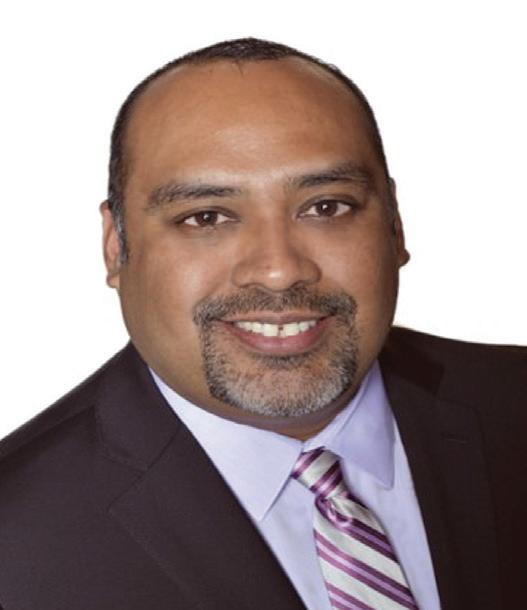
Administration as well as protect California laws, institutions, and policies, Bonta said.
The funding is two-fold. First, Senate Bill SBX1-1, authored by Scott Weiner (D-San Francisco) and Assemblymember Jesse Gabriel (D-Encino) amends the 2024 Budget Act to include a State Litigation Fund, distributing $25 million to the DOJ. SBX1-1 was enacted in case the Trump Administration decides to withhold funding for emergency aid after a natural disaster such as the wildfires that occurred in Los Angeles. The DOJ says it intends to go after the federal government in courts if aid is withheld.
The second bill that was born out of the Special Legislative Session called by Newsom, SBX1-2, amends the Budget Act to add funding for Legal Services, including $25 million for legal assistance for Californians and immigrant communities.
Authored by Weiner and Gabriel, SBX1-2, also allows the DOJ to provide free legal services for veterans, people with disabilities, homeless youth, families facing eviction, seniors, victims of domestic violence, wage theft, and human trafficking.
Bonta stated that the funding is sufficient and that his office is staffed to handle litigation that resists obstructive policies and interference from the Trump Administration.
The funds would be used “wisely and prudently and efficiently,” Bonta said.
“I am here to provide facts, reasons, and assurances of California’s nation-leading protections,” Bonta said. “I am here to enforce our laws, defend our rights, and protect our people. I am here to ensure progress prevails in California.”
Capitol Weekly hosts quarterly conferences for bipartisan panels to analyze public policy issues in the state and across the nation. This year’s first conference included over a dozen experts discussing how California activists and officials can defend policies that oppose Trump’s injunctions.
The first panel focused on health care. The spirited debate featured Beth Malinowski, SEIU California; Devon Mathis, former California Assemblymember (R-Porterville); Dr. Richard Pan, former California Senator; and Amanda McAllister Wallner, Health Access California.
continued on page 3
Antonio Ray Harvey | California Black Media
Asm. Rhodesia Ransom (D-Stockton) introduced Assembly Bill (AB) 13 on the day she was sworn into office.
Rob Bonta, California Attorney General.
David Trujillo, ACLU California
Thursday, March 13, 2025
Chaffey Adult School’s Multicultural Fair brings cultures together to celebrate the rich traditions that bring communities together
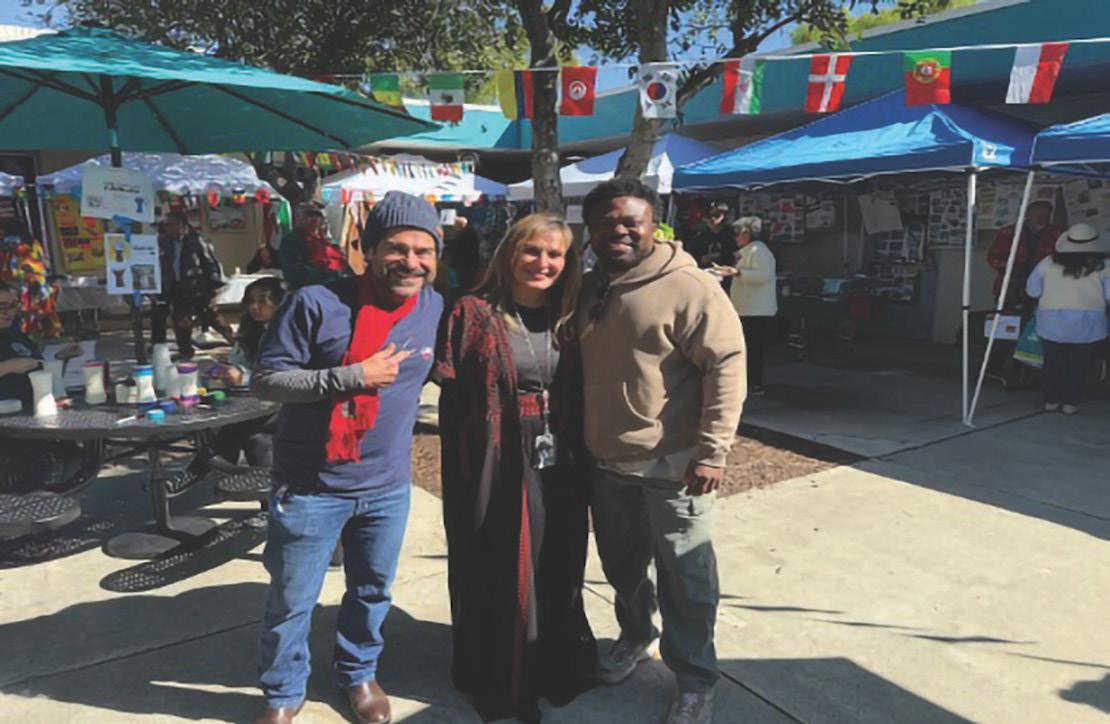

How Head Start Helped Her Reach the ‘Summit’ of Success
BLACKPRESSUSA NEWSWIRE — all leading to the launch of her own company. Cicely’s educational journey began at the Cannon County Head Start program, which set her up to excel in kindergarten and high school.
By Malkia Payton-Jackson, National Head Start Association

ONTARIO, CA – Born and raised in the United States, Ghattas Khoury has always felt a deep connection to his Jordanian heritage. At Chaffey Adult School’s 4th Annual Multicultural Fair on March 8, he volunteered at a booth showcasing traditional clothing, books and artifacts from Jordan and the Arab region. His message was simple yet powerful: “Be proud of where you came from, and be proud of where you’re at.”
The booth was one of dozens celebrating cultures from around the world as Chaffey Adult School’s 5th Street campus transformed into a vibrant hub of cultural exchange. Featuring live performances, international cuisine, art and interactive displays, the Multicultural Fair – the first since pre-pandemic
2020 – provided a space for community members to embrace diversity, learn from one another, and strengthen the bonds that make the Inland Empire such a dynamic region.
“The Multicultural Fair is more than a celebration –it’s an opportunity to foster understanding and appreciation for the incredible range of cultures represented in our community,” said Dr. George Matamala, Principal of Chaffey Adult School. “Every year we’ve hosted this event, it has brought people together, reminding us that our differences make us stronger. This was especially true this year, after a five-year hiatus.”
Organized by Dr. Nora Hourani-Farraj, Assistant Principal of Chaffey Adult School and Director of Community Relations for the Chaffey Joint
Union High School District, the fair also featured a Community Resource Fair, connecting attendees with organizations such as House of Ruth, Inland Empire Health Plan, Molina Healthcare and the Mexican Consulate.
“The diversity of our community is our greatest strength,” said Dr. HouraniFarraj. “This event is a way for us to celebrate that diversity while also providing valuable resources to those who need them.”
Chaffey Adult School serves more than 3,000 students annually, offering a range of educational opportunities to support lifelong learning and career advancement. The Multicultural Fair reflects the school’s commitment to embracing different backgrounds and perspectives, ensuring that all students and community members feel seen, valued, and supported.
“The Chaffey Joint Union High School District is proud to support events that promote inclusion and cultural awareness,” said Dr. Mathew Holton, Superintendent of Chaffey Joint Union High School District. “Now, more than ever, it is essential to come together as a community and celebrate the rich traditions that make us who we are.”
From the rhythmic beats of traditional music to the flavors of global cuisine, the Multicultural Fair was a testament to the power of cultural exchange. As attendees left with a newfound appreciation for their neighbors’ heritage, one message rang clear: celebrating diversity strengthens the entire community.
For more information about Chaffey Adult School and its programs, visit https://cas. cjuhsd.net.
URGENT REPORT-Dangerous Chemicals Detected in 100% of Tested Braiding Hair
By Leigh-Ann Jackson


Whether they want to streamline their beauty regimen, add some gorgeousness before vacation, or prepare their little ones for a few weeks at sleepaway camp, many Black people will pick braided hairstyles as their go-to.
Braids can deliver a look that’s chic, versatile, and no-fuss. Well, there’s some fuss, if you factor in the hours-long installation process. They can be worn for weeks at a time, minimizing the need for daily hair maintenance and all the copious products, breakage, heat, and wear and tear that come with it.
Deeply rooted in Black culture - not to mention centuries of African aesthetic traditions - and frequently worn by celebrities such as Michelle Obama, Beyoncé, Kerry Washington, Robin Thede, and Halle Bailey; and social media influencers, the popularity of braids and faux locs isn’t waning anytime soon.
In addition to being beautiful, desirable, and a time-saver, braids can be accessible. While some braided hairstyles can come with four-digit prices, many consumers can obtain a pack of synthetic braiding hair for as little as a few dollars on Amazon or at their local beauty supply store, then make an appointment with their braider of choice. If they are able to, they can even braid their hair themselves.
But could these beloved “protective styles” actually be doing more harm than good?
Intricate designs, varying sizes, with curls, without curls, butt-length or shoulder-length, braids come in many styles, and braiders are the key to giving their clients their desired look.
After experiencing a braiding debacle two years ago, Chrystal Thomas, a student at the Albert Einstein College of Medicine and the City University of New York, set out to find an answer to this very
question.
Thomas says she went to a professional stylist to have braids done using what she recalls was the popular synthetic hair brand Kanekalon. Her problems started that same day, she says: “I couldn’t sleep well, my throat felt irritated, and I had trouble focusing on any type of work I was doing because of the smell. The smell wouldn’t go away even after washing my hair multiple times.”
Experiencing constant discomfort, she removed her braids a week and a half later. Typically, people wear braided styles for several weeks. She then decided to research possible health issues tied to braiding hair as part of her public health coursework, and she published her findings in a commentary article about the risks of carcinogenic materials in hair products for Black women. Contacted about this complaint, Kaneka responded, “Kaneka only manufactures the Kanekalon fibers that are used in various hair products, such as synthetic hair braids and wigs, and does not produce any of the final products.”
The company went on to say that other companies take those fibers and process, dye, customize, and distribute the actual final products that consumers then purchase. The company added that it would need more information to fully investigate the complaint.
Thomas is not the only person to have this experience.
Black women are the primary users of these products, and people of African descent are the largest group of consumers of hair wigs and extensions. In 2023, the U.S. market for these products was valued at $2.79 billion and is expected to reach a value of $6.34 billion by 2029.
Thomas’ goal was to spark a conversation about how the
high usage may be putting Black communities at risk. The article called into question the safety of synthetic hair, which may be made from a copolymer of modacrylic and vinyl chloride and can include other chemicals with known links to adverse health effects.
“What is unique about braid extensions is the length of exposure users have to them,” Thomas says. “Synthetic braids are typically worn for about four to six weeks. Black women and other individuals who use synthetic hair are, therefore, exposed to those ingredients consistently during that time.”
To begin to understand how much risk synthetic braiding hair poses, CR scientists tested 10 popular synthetic braiding hair products for heavy metals and volatile organic compounds (VOCs). Here are the top findings:
• Carcinogens, or chemicals that may cause cancer, were detected in 100 percent of the samples.
• Lead was detected in nine of 10 products.
• Other VOCs, including acetone, were detected in all products.
How CR Tested Synthetic Braiding Hair
Consumer Reports has a long history of testing products for chemical contamination and evaluating their comparative safety. When synthetic braiding hair test leader James E. Rogers, PhD, director and head of product safety testing, and his team set out to begin this testing in 2024, he says, he had three goals—to determine whether the chemicals were present, to determine whether you could measure them/how much of each chemical was present, and to find out whether there was a way to determine the possible risk to the consumers who use these products.
This is a topic that is near and dear to Rogers. “My two daughters wear braids often, and I have helped with purchasing the hair and the braid takedown many times over the years,” he says. His team tested two samples each of 10 of the most popular products on the market. All products were a version of black or dark brown hair.
Carcinogens Detected in Synthetic Braiding Hair
Carcinogens are chemicals that
may cause cancer; they’re classified in three ways, according to Eric Boring, a CR scientist with a PhD in chemistry.
Known: There is strong scientific data to link the chemical to cancer. Usually, this means multiple (more than three) sources confirming this and there is very little argument within the scientific community.
Probable (aka likely): There is significant data (at least two to three sources) confirming this, although there might be some dispute in the scientific community.
Possible: There might be only one set of data confirming this, or there is substantial dispute within the scientific community, or we might have data confirming that a similar chemical is carcinogenic.
All the synthetic braiding hair products tested contained multiple carcinogens. Three products contained benzene, a known carcinogen that causes acute myeloid leukemia. “It is strictly regulated and discouraged to use in laboratories because of its potential to cause cancer,” Rogers says. Two products contained an animal carcinogen, and all the samples contained a probable carcinogen, methylene chloride.
Lead in Synthetic Braiding Hair
Heavy metals, such as arsenic, mercury, lead, and cadmium are found in a variety of foods. CR has previously reported that there is arsenic in rice; mercury in tuna and other fish; cadmium in several foods, including baby food made with sweet potatoes and rice; and lead and cadmium in a variety of chocolate bars. Because you can be exposed to heavy metals in so many ways, it’s important to know where they are and to minimize exposure where you can; for example, by reducing your consumption of certain chocolate products and certain fish.
CR tested the braiding hair samples for heavy metals, including arsenic, cadmium, and lead. None of the products had detectable arsenic. “Three of the products had detectable cadmium, but our exposure and risk analysis found the levels did not pose a risk,” Rogers says. Lead, however, was detected in nine of the 10 products. “Our
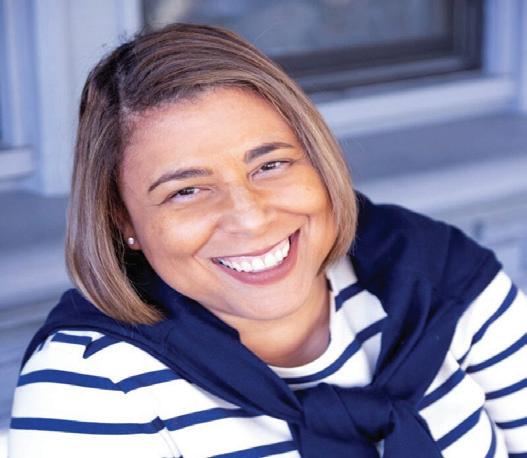
Simpson is the founder and CEO of Summit Public Affairs in Washington, D.C., a long way from her beginnings in the small town of Woodbury, Tennessee. She credits her Head Start for her successful journey from small-town roots to attending law school and working in congressional offices, all leading to the launch of her own company. Cicely’s educational journey began at the Cannon County Head Start program, which set her up to excel in kindergarten and high school. Cicely went on to pursue higher education, earning a bachelor’s degree in political science from Lipscomb University in Nashville. From there, with her heart set on practicing law, Cicely left Tennessee for Pepperdine University School of Law in California. Cicely achieved her goal, starting her career as a criminal prosecutor in Los Angeles, but deciding California was not for her, Cicely returned to Nashville and continued her legal career there. Next came a professional turn that Cicely herself would not have predicted.
A Growing Career
“When one door closes, one door opens,” Cicely said, explaining the shift in her career and the start of her journey in Washington. Soon after returning to Nashville, a couple of friends convinced Cicely to join them in working for Rep. Lincoln Davis’s first Congressional campaign. When he won the election, Rep. Davis invited Cicely to join him
in Washington as his Legislative Director. Cicely accepted, and over the next six years, she worked with Rep. Davis and Rep. Jim Cooper on furthering their public policy goals in the U.S. Congress. Then came the next professional turn. Cicely left the Hill and began her lobbying career by opening a Washington, D.C., government relations office for Dunkin Donuts and Baskin Robbins. This role led her to the National Restaurant Association, where she served as the executive vice president of public affairs at the trade association for several years. Now, as the president and CEO of her own company, Cicely is applying her years of experience and expertise in public affairs to support a wide range of clients with their advocacy, risk management, and communication needs.
Big Believers in Head Start, Then and Now
“I’m blessed to have come from a family who are big believers in Head Start, both then and now,” she said. “My brother attended Head Start, I went to Head Start, my nephew went to Head Start, my cousins went to Head Start, and we all went to Head Start in the same community.” Cicely’s firm belief that Head Start was imperative to her own educational and professional journeys, as well as those of her family members, makes her a dedicated Head Start advocate. “When I was in Congressman Davis’s office, as well as Congressman Cooper’s office, we signed on to every letter, every bill, we supported every opportunity to support Head Start financially from the Capitol Hill perspective,” Cicely explained, “We knew, and we know—I won’t say past tense because currently, we know— how important it is.”
From left: George Matamala, Principal of Chaffey Adult School; Nora Hourani-Farraj, Assistant Principal of Chaffey Adult School and Director of Community Relations for the Chaffey Joint Union High School District; and Dr. Kern Odua, Assistant Superintendent of Student Services for the Chaffey District
From left: Ghattas Khoury, Jessica Hauske, Rana Houch and Angela Khoury.
When the synthetic hair is heated, VOCs are released into the air. These beautiful butterfly braids were installed in February at a braiding salon in Brooklyn, N.Y. Photo: Noémie Tshinanga
An American elementary school girl smiles at the camera as she sits at her desk.
Cicely
THE SAN BERNARDINO AMERICAN NEWS - GOVERNMENT/BUSINESS
Onyx Impact Unveils CuttingEdge Platform to Combat Digital Deception

“We All We Got: A Digital Green Book for the Culture” will Empower Black Communities to Navigate Digital Manipulation and Misinformation
ATLANTA, GA — Onyx Impact, the organization that empowers Black communities by fighting false and misleading information and promoting healthier digital spaces, today announced the launch of “We All We Got: A Digital Green Book for the Culture,” a comprehensive online platform designed to equip Black communities with the tools and knowledge to counter digital manipulation and deceptive narratives.
Inspired by the original Green Book that guided Black travelers to safe spaces during segregation, this modern iteration serves as a trusted resource for navigating today’s complex digital landscape. The platform offers actionable strategies to identify and counteract online threats, ensuring users can engage with digital content confidently and safely.
“In an era where digital manipulation is rampant, it’s crucial for Black communities to have reliable resources to discern truth from deception,” said Esosa Osa, Founder and CEO of Onyx Impact. “This Digital Green Book will help Black families navigate the online world with clarity and confidence.”
The Digital Green Book serves as a centralized hub where users can access factchecked information, learn
to recognize and counteract social media manipulation and develop healthy digital habits. By fostering a community of trusted voices and credible resources, the platform empowers users to protect their families and make informed decisions in increasingly deceptive online spaces.
Key features include:
Protect Our Truth: Resources to recognize and challenge misinformation targeting Black narratives.
Protect Our Kids: Guides for safeguarding Black children from online dangers, including cyberbullying and algorithmic bias.
Protect Our Culture: Tools to preserve and promote Black culture in digital spaces.
Onyx Impact invites individuals, organizations, and allies to explore the Digital Green Book and join the collective effort to combat misinformation. For more information and to access the Digital Green Book, visit https://www.digitalgreenbook. org/digital-green-book.
About Onyx Impact
Onyx Impact is a nonprofit organization founded to better serve and empower Black communities by fighting the harmful information ecosystems targeting them.
CONTACT: Nina Smith, nina@polisolpublicaffairs.com
Stopgap Bill Advances as Congress Moves to Prevent Shutdown
by Stacy M.
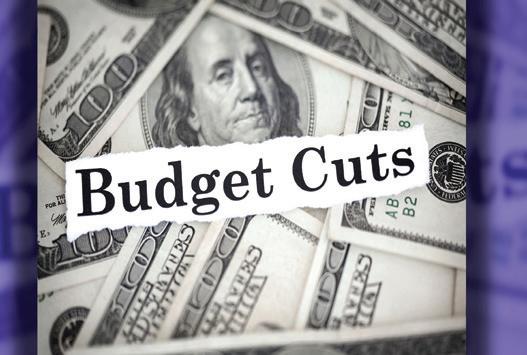
The
Cuts" with hundred dollar bills in the background.
A newly introduced stopgap bill in Congress aims to extend government funding through the end of the 2025 fiscal year, providing critical financial support for federal agencies and essential programs. The legislation, formally titled the “Full-Year Continuing Appropriations and Extensions Act, 2025,” is designed to avert a government shutdown, but its broader implications extend across the country. The bill sustains funding for federal agencies that oversee national healthcare, education, housing, and law enforcement programs. Medicaid provisions remain intact, delaying cuts to Disproportionate Share Hospital (DSH) payments, which assist hospitals serving low-income patients. Republicans said the extension ensures continued care for vulnerable populations in states heavily reliant on federal healthcare dollars. Housing and urban development programs also remain funded, preserving rental assistance and homelessness prevention initiatives. However,
Stopgap Bill Advances as Congress Moves to Prevent Shutdown...continued
essential programs, while others argue that maintaining current spending levels is necessary to avoid further fiscal uncertainty.
The proposed budget levels are expected to impact public safety, education, and infrastructure spending across multiple states.
Rep. Rosa DeLauro (DCT), the leading Democrat on the House Appropriations Committee, sharply criticized the measure, calling it a “blank check” for billionaire Elon Musk.
“I strongly oppose this full-year continuing resolution, which is a power grab for the White House and further allows unchecked
billionaire Elon Musk and President Trump to steal from the American people,” DeLauro said. Democratic leaders Hakeem Jeffries, Katherine Clark, and Pete Aguilar echoed those concerns in a joint statement.
“Republicans have used their control of the House, the Senate, and the presidency to destroy the programs taxpayers deserve to fund tax cuts for their billionaire donors and wealthy corporations. They are cutting healthcare access, public schools, and veterans’ benefits while soaring the costs of groceries, housing, and insurance. They are making our communities less safe by cutting law enforcement and threatening our national security.”
The statement continued: “In one week, funding for the government runs out. The top Democrat on the Appropriations Committee, Rosa DeLauro, remains ready to negotiate a meaningful bipartisan
spending agreement that puts working people first. However, Republicans have decided to introduce a partisan continuing resolution that threatens to cut funding for healthcare, nutritional assistance, and veterans benefits through the end of the current fiscal year. That is not acceptable.”
House Democrats said they would enthusiastically support a bill that protects Social Security, Medicare, veterans’ health, and Medicaid, but Republicans have chosen to put them on the chopping block to pay for billionaire tax cuts. “We cannot back a measure that rips away life-sustaining healthcare and retirement benefits from everyday Americans as part of the Republican scheme to pay for massive tax cuts for their wealthy donors like Elon Musk. Medicaid is our red line,” the Democratic leaders stated. The outcome will determine funding levels for programs millions of Americans rely on daily. “This [measure] means a nearly $945 million cut for critical services, impacting teachers, firefighters, and law enforcement,” said D.C. Council Chairman Phil Mendelson (D). “The effect of what they’re trying to do would be to cut back spending by police and other public safety agencies as well as agencies that deal with the cleanliness of the city, public education, and so forth. They would realize no savings from this because these are not federal dollars.”
California vs Trump: Attorney Gen. Bonta Lays Out “Resistance” Plan...continued from page 1
The second panel discussed California’s environment and climate. Kip Lipper, Chief Policy Advisor on Energy and Environment to the Senate proTem; Catherine Reheis-Boyd, Western States Petroleum Association; and Victoria Rome from the Natural Resources Defense Council.
The final panel included Sen. María Elena Durazo (D-Los Angeles); Luis Alvarado, Luis Alvarado Public Affairs; Kevin R. Johnson, University of California at Davis School of Law; and David Trujillo, American Civil Liberties Union (ACLU) California Action.
“It’s going to take every resident in the state working together to say ‘we’re going to stand up for our neighbors,’” Trujillo said during the panel discussion.
concerns persist that flat funding levels will not account for rising costs, leaving states and local governments to bridge potential gaps in affordable housing efforts. Education funding remains steady, but school districts that depend on federal support may face difficulties maintaining services as costs increase.
The bill also upholds funding for federal law enforcement agencies, including the U.S. Marshals Service, FBI, and other key institutions responsible for public safety. Grants supporting state and local policing initiatives are maintained, though some lawmakers argue additional resources are needed to address crime prevention and community policing efforts. Beyond immediate fiscal concerns, the bill extends the authority of the U.S. Parole Commission for another year, continuing federal oversight in key areas of criminal justice. In some regions, officials and advocates have pushed for more localized control over parole and sentencing decisions, but the current measure ensures federal jurisdiction remains unchanged. Lawmakers on both sides of the aisle have weighed in on the bill’s broader implications. Some have criticized the measure for failing to provide increased funding for
The Trump administration has already begun exerting pressure on Sanctuary Regions – cities, counties, and states that have passed policies that shield undocumented individuals from apprehension by U.S.
Immigration and Customs Enforcement (ICE).
Trump has threatened to prosecute state and local officials who resist federal immigration policy. After he was sworn in for his second term, his administration keyed in on the sanctuary cities across the country.
California, where roughly 6% of the population is undocumented, is clearly on Trump’s radar, the panel acknowledged. Trujillo said that there is a law that limits the federal government’s power to force states to enforce immigration laws.
“I just want to mention that the 10th Amendment (of the U.S. Constitution) prevents the federal government from commandeering states or other cities and counties from law enforcement,” Trujillo said.
“That is the safeguards that we have. I think we have a clear precedent here (in California). A lot of this is rambling to create fear among our communities.”
Slotkin rips 47th president’s ‘reckless’ agenda in fiery rebuttal: ‘He’ll make you pay’
By Stacy M. Brown
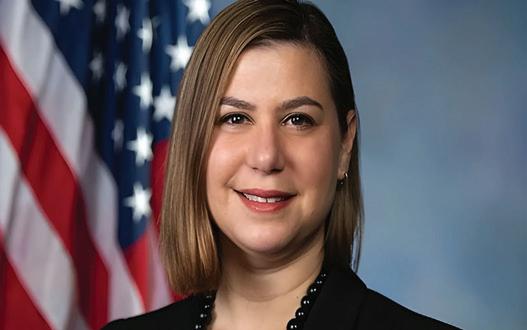
Calling the president’s federal layoffs a “mindless” purge, Sen. Elissa Slotkin criticized his leadership, warning his billionaire-friendly agenda could endanger national security. Photo: Photo courtesy of NNPA
“Trump is on the hunt to find trillions of dollars to pass on to the wealthiest of Americans, and to do that, he’s going to make you pay,” she said, tearing into his trade policies, rising prescription drug costs and ballooning national debt.
Slotkin also aimed the Trump administration’s sweeping federal layoffs, which she
Slotkin rips 47th president’s ‘reckless’ agenda in fiery rebuttal: ‘He’ll make you pay’...continued returns, your health information and your bank accounts?” she asked.
Slotkin didn’t hold back on foreign policy either, skewering Trump for his embarrassing Oval Office clash with Ukrainian President Volodymyr Zelenskyy.
“That wasn’t just a bad episode of reality TV,” she said.
“It summed up Trump’s whole approach to the world. Cozy up to dictators like Vladimir Putin,
kick our allies like the Canadians in the teeth, and call it strategy.” The Illinois senator, a former CIA analyst, framed the stakes as a choice between responsible leadership and reckless upheaval.
“America wants change, but there’s a responsible way to make change and a reckless way,” she said. “We can make that change without forgetting who we are as a country and as a democracy.”
Ramos names youth advocate Eunice
Abel as Woman of the Year for
Assembly District 45
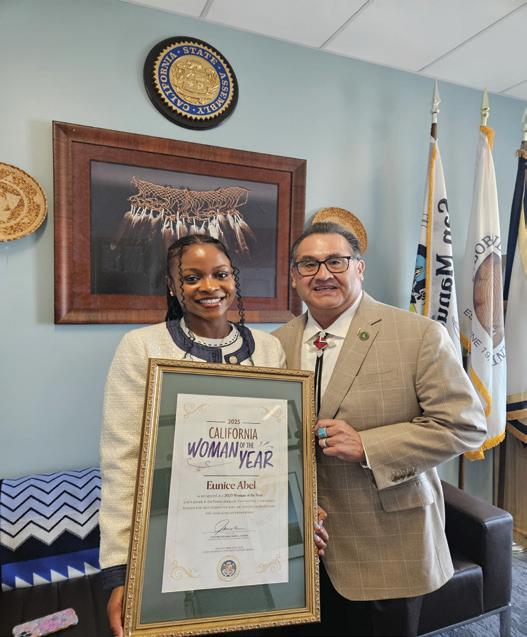
SACRAMENTO—
Assemblymember James C. Ramos (D-San Bernardino) today named Eunice Abel, a youth advocate and undergraduate student, as 2025 Woman of the Year for Assembly District 45.
Assemblymembers, including Ramos celebrated their honorees on the Assembly floor today.
“Eunice is a tireless and steadfast advocate for young people in the Inland Empire and is dedicated to eliminating inequities,” Ramos said. “She is especially committed to addressing youth homelessness, a legislative priority for me since my election. Even at her young age of 22, she has built an exemplary record of positive action and contributions to our community,” Ramos stated.
Abel, born in Aba, Abia, Nigeria, immigrated to the United States at 11 years old and navigated life as an unaccompanied minor throughout
her childhood. She confronted countless obstacles, including unstable housing, poverty and difficulty in accessing an education. This struggle fueled her passion for advocacy and inspired her to become a youth homeless advocate.
“This award is a testament to youth who are fighting to empower other youth, showing that our work is valuable and that standing up for others is not a waste of time,” Abel said. She has served as a youth ambassador for non-profits that support underprivileged youth. In 2022 Abel was elected Chairperson for the Youth Advisory Board of San Bernardino County where she supported several initiatives to aid homeless youth in San Bernardino County. She later became Youth Leadership Coordinator and revived the Youth Advocacy Summit. This summit brought together legislators, service providers, and youth in San Bernardino County to raise awareness and facilitate meaningful conversation about youth homelessness.
Her advocacy extends to other policy areas that affect the overall well-being of California youth such as food insecurity, immigration and racial equity. Abel will graduate with her Bachelor’s degree in Public Policy this spring from University of California, Riverside.
Top scams of 2024
By BCP Staff
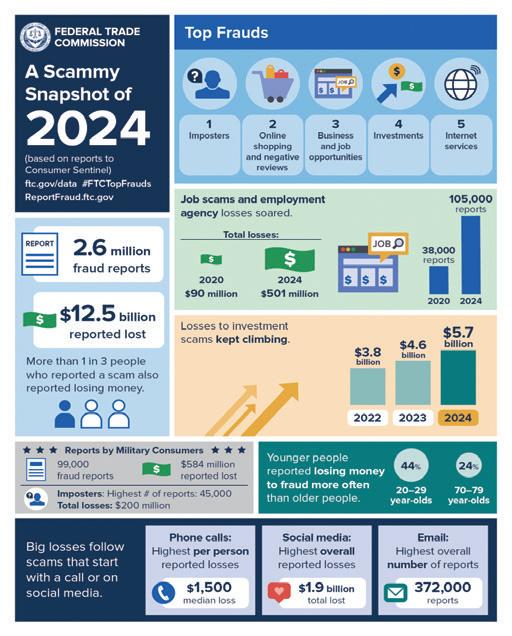
called a “mindless” purge of critical workers. “The firing of people who protect our nuclear weapons, keep our planes from crashing and conduct life-saving research—only to rehire them two days later? No CEO in America could do that without being summarily fired,” she said.
Speaking from Wyandotte, Mich., Slotkin positioned herself as a voice for working-class Americans frustrated by rising costs and political dysfunction. She called out Trump’s coziness with billionaires like Elon Musk, warning that their unchecked influence could jeopardize everything from Social Security to private financial data.
“Is there anyone comfortable with Musk and his gang of 20-year-olds using their own servers to poke through your tax
Did you or someone you know report a scam to the FTC in 2024? Thank you! Those reports help the FTC bring enforcement cases and educate people about scams. Let’s jump into the top 2024 scams. The headline is this: even though the number of fraud reports is roughly the same as last year, more people lost a lot more money to fraud. One in three people who reported fraud said they lost money (up from one in four last year), adding up to $12.5 billion (up $2.5 billion from 2023). People lost over $3 billion to scams that started online, compared to approximately $1.9 billion lost to more “traditional” contact methods like calls, texts, or emails. However, people lost more money per person (a median of $1,500) when they interacted with scammers on the phone. And, once again, imposter scams topped the list of scams reported.
Here are some other things to know:
The biggest scam losses
happened by bank transfer or payment. Among all payment methods, people reported losing more money through a bank transfer or payment ($2 billion), followed by cryptocurrency at $1.4 billion. Investment scams led to big losses. A majority (79%) of people who reported an investment-related scam lost money, with a median loss of over $9,000. The $5.7 billion losses in this category are up about $1 billion from last year. People reported losing money more often when contacted through social media. Most people (70%) reported a loss when contacted on a social media platform — and lost more money overall ($1.9 billion). Job scams and fake employment agency losses jumped — a lot. Between 20202024, reports nearly tripled and losses grew from $90 million to $501 million. Younger people lost money more often. People aged 20-29 reported losing money more often than people
Brown NNPA Newswire Senior Correspondent
words "Budget
Thursday, March 13, 2025 THE SAN BERNARDINO AMERICAN NEWS - HEALTH/LIFESTYLE/FINANCIAL/RELIGION
Visits to Community Health Clinics Drop as Fears of ICE Raids Escalate
By Sunita Sohrabji
Visits to community health clinics are dropping as fears escalate of ICE raids. But Dr. Jose Perez, CMO of the South Central Family Health Center, says ICE cannot conduct random dragnet sweeps.
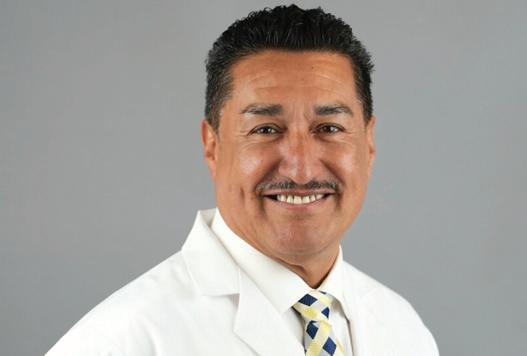
Dr. Jose Perez, Chief Medical Officer at the South Central Family Health Center. (Photo provided)
As Immigration and Customs Enforcement raids increased dramatically over the past two months, community health clinics saw a substantial drop in client visits.
“We’ve been hearing all these rumors that there will be an increased ICE presence in Los Angeles,” said Dr. Jose Perez, Chief Medical Officer at the South Central Family Health Center. “So clearly it has rattled the community. That’s what’s preventing folks from coming in. They don’t really know if ICE is active, when ICE will come, and where they are going. And so rather than risk it, they just don’t come into the clinic,” he said in an interview with Ethnic Media Services.
Such fears are not unfounded. Perez noted reports of ICE vans in February parked outside a community health clinic in Adelanto, California. Though agents did not go into the facility, the tacit threat was enough to keep many clients away.
The drop in client visits comes amid the quad-demic of influenza,
VoteVets Announces
bird flu, RSV, and Covid-19. The US is facing the worst flu season it has experienced in 15 years. The Centers for Disease Control and Prevention report 37 million infections as of Feb. 25, with 480,000 hospitalizations, and 21,000 deaths. 98 children have died of influenza this season.
The South Central Family Health Center serves 34,000 clients. About 1/3 are newer immigrants. In a normal year, the clinic would host 117,000 client visits. Nationally, 1400 Federally Qualified Health Centers serve approximately 31 million people.
In this interview, Perez spoke about the challenges of ensuring his clients get the care they need amid fears of deportation.
Dr. Perez, have you seen a significant drop-off in the number of people that are now coming to the clinic?
Dr. Jose Perez: Yes. Given the current situation, they’re becoming afraid of coming into the clinic. The clinic has made available more telehealth visits for patients that do not want to come in. And so we are seeing an uptick a little bit in our telehealth. But the reality is that our patients, when they don’t come to the clinic, they just forego medical care altogether.
We’ve had extensive
a $1 Million Targeted Veteran and National Security Expert Candidate Recruitment Initiative
Leveraging our resources, strengths, and successes, VoteVets is investing in a winning strategy to shape our democratic leadership for the next generation.
Washington, DC. - Following a historic investment in the Virginia Governor’s race and successful work shaping the narrative around Elon Musk’s reckless actions within the administration, VoteVets is announcing an innovative new candidate recruitment effort, building a pipeline of the next generation of veteran and national security expert elected leaders. Over the next three years, we will mount an aggressive recruitment effort, building out the infrastructure for ongoing identification and cultivation of veteran and national security expert candidates with dedicated staff, data-driven models, and robust relationships with existing local and state leadership.
When veterans and national security experts speak, Americans listen: the first Gallup poll of 2025 once again ranked military officers as among the top three most ethical and honest professions. Americans consistently turn to veterans and national security experts as the standard-bearers for decency, security, and integrity in their communities. Even amidst 2024’s widespread losses, VoteVetsendorsed candidates clinched 143 victories across local, state, and federal races, including Senators Ruben Gallego, Elissa Slotkin, and Andy Kim, and Congresspersons Pat Ryan, Jared Golden, and Maggie Goodlander. When our candidates run, they win. We can build a powerful surge that will deliver key wins for the Democratic Party across state and local public offices — if we stand up strong veteran and national security expert candidates.
The Voter File: VoteVets’ proposed recruitment program is rooted in our access to a highly valuable and singular asset: our Veteran and Military Family Voter File. The file contains 10 million names of verified and modeled vet and military affiliated voters, representing a valuable well from which to draw candidates for local and state offices.
Over the past few cycles, VoteVets has used its access to the Voter File to recruit veterans for a wide variety of actions, among them voter contact, signing pledges, press, and events.
discussions at a leadership level. Obviously, as a federally qualified health center, we need to abide by laws and regulations. For example, abiding by immigration rules may come in conflict with HIPAA rules. So what our organization has decided is that once patients have been processed and are in the back office, then all the HIPAA rules that we are mandated to follow come into effect.
We are a private company. So in order for ICE agents to enter any other areas beyond the waiting area, they must have some kind of a legal document stating why they’re there and who they’re there for. They are not allowed to look at anybody else’s charts or anybody else’s medical information. And that is how we protect our patients and protect the organization from breaking HIPAA rules.
You mentioned that parents are not bringing in their children, even those who are documented or hold US citizenship. And we’re on the cusp of a measles outbreak in Texas and New Mexico.
Yes, absolutely. If a parent is afraid to come to the clinic for their own sake, bringing their child brings with it the same sort of danger. So American-born children forego vaccinations, forego physical exams. And so we put our own American citizens in danger when that comes around.
Additionally, a lot of these folks who are applying for
green cards and changes in status remember four years ago with the public charge rule. Anybody getting healthcare or getting any kind of help is considered “undesirable” to get a green card, even folks who have been living here for years and are documented.
So now they may not reapply to Medi-Cal. They may not use their Medi-Cal because they don’t want any record of their use of a benefit that they are entitled to legally to come back and bite them and prevent them from obtaining their immigration status adjusted. And so it is a big burden on our patients.
We are doing all we can to to educate our patients what their rights are and what folks in the government can and cannot do. And our hope is that has an impact, that they trust us enough to come in, get their health care and even get their health care via telehealth and use whatever tools are available so we can at least give them guidance as to how to treat their ailments.
We are amid a quad-demic. Given the significant drop-off in client visits, what would you say about the overall health of your community right now?
I’ve been in the community health center realm for the last 25 years since I graduated from residency. Back in the late 1990s, we had a program called the Public Private Partnership in LA County. This was the LA County’s efforts to provide medical services to the uninsured.
continued on page 6
“The Nerve of Man─Thinking He Knows Better Than God!”
By: Lou K Coleman
The Voter File has been used to send texts to 2.5 million possible veterans to confirm their veteran status and make sure they had the information needed to vote, with an incredibly high contact and response rate. Each of these responses deepen the profiles of the veterans in the file, creating dossiers that incorporate their military branch of service and the political and community issues that matter most to them.
Reaching into the Voter File to recruit potential candidates is likely to return investment at the local level initially, and with planning and scaffolding can also be the beginning of long political careers that follow a progression of leadership roles.
The Natural Leadership Ladder: Forty-five percent of VoteVetsendorsed federal candidates (nonincumbents) in 2024 were serving in a state or local elected capacity when they stood for election. Leaning into this progressive escalation of elected roles, VoteVets is actively building relationships in all 99 state house and senate caucuses as well as within local labor affiliates to steward a long-term engagement with local elected leaders — years before there is an opening to run for higher office. Whether candidates follow the examples of Pat Ryan (County Executive > Congress) or Ruben Gallego (State Representative > Congress > US Senate), VoteVets will build the capacity to shepherd in a full scale movement rooted in democratic values, renewable with each new local candidate recruited, preparing each to ascend steadily to higher, more influential office.
Key Initiatives Strengthen relationships with all 99 state house and senate caucuses, as well as local National Education Association (NEA) affiliates. Invest in early engagement with potential candidates, ensuring VoteVets plays a pivotal role in their political development.
Highlight success stories like Pat Ryan (County Executive to Congress) and Ruben Gallego (State Representative to Congress to U.S. Senate) to inspire and guide emerging leaders.

Wail! For there is a way that seems right to a man, but its end is the way of death. [Proverbs 14:12].
Man can’t even begin to compare. The essence of God: Sovereign, Almighty, Omnipotent, Omniscient, Omnipresent, Infinite, Eternal, and Immortal, to mention only a few. No list of adjectives could ever adequately picture the immenseness of God. Because he is God, no words or thoughts of mortal men and women could ever compass his greatness. He is far bigger than we imagine, His presence fills the universe, He is more powerful than we know, wiser than all the wisdom of the wisest men and women, His love is beyond human understanding, His grace has no limits, His holiness is infinite, and His ways are past finding out. He is the one true God. He has no beginning and no end. He created all things, and all things exist by His divine power. Our best efforts fall so far short of his divine reality that we flatter ourselves to think that we truly understand him at all. It is against that backdrop that we must consider the meaning of verses such as “The secret things belong to the Lord our God” [Deuteronomy 29:29] and “As the heavens are higher than the earth, so are His ways higher than our ways and His thoughts than our thoughts” [Isaiah 55:9]. With such a lack of knowledge that we have about how this world works, why do we ever think that we know better than the Lord? Satan lied to Eve when he tempted her to disobey God.
“The Nerve of Man─Thinking He Knows Better Than God!”...continued
government by using phrases like Global Management, the Rule of World Law; Collective Sovereignty, the Interdependence of Nations, a Global Village, and Collective Security which is nothing more than catch words for a one-world agenda. I tell you, the nerve of man thinking he knows better than God.
As Elon Musk said at the 2023 World Government Summit in Dubai, United Arab Emirates remotely via video call.
I know this is called the “World Government Summit,” but I think we should be a little bit concerned about actually becoming too much of a single world government," Musk said. Musk referenced the fall of Rome, which took place in the 5th century, as an example of civilizational collapse. Musk explained, "While Rome was falling, Islam was rising, so you had a caliphate doing well while Rome was doing terribly. And that ended up being a source of preservation of knowledge and many scientific advancements."
"So, I think we need to be a little conscious of being too much of a single civilization because if we are too much of a single civilization, then the whole thing may collapse," he continued. I'm obviously not suggesting war or anything like that. But I think we want to be a little wary of actually cooperating too much," Musk concluded.
"It sounds a little odd, but we want to have some amount of civilizational diversity so that if something does go wrong with some part of civilization then the whole thing doesn't just collapse and humanity keeps moving forward."
Musk later quipped on Twitter that the World Government Summit "seemed like the right venue" to spread the message.
"If I may say, we want to
He said, “Ye shall be as Gods.” [Genesis 3:5]. Since that day, man decided that he wanted to be god and that he wanted to create a “New World Order” without God.
As far back as the Tower of Babel, mankind has dreamed of a one-world government. Mankind, commanded by God to diversify over the face of the earth, chose, instead, to remain together in one place, in defiance of their Creator’s desire. Yet, it was not then God’s will that humanity be united in one location under one human government, and He intervened to scatter humanity across the earth by dividing the languages of man [Genesis 11:1-8], but now the globalists are attempting to undo what the Lord did. They want to rebuild a type of Babel.
The nerve of man, thinking they know better than God. Wail!
Unfortunately for us, that time and what seemed so unbelievably futuristic at one point is now becoming a reality ─our cashless society, microchips and digitized tracking systems...all evidence that the stage is setting itself just as it was prophesized in the Book of Revelation. The Mark of the Beast: One World Government, One World Religion, One World Economic. [Revelation 13:1618].
Today, the United Nations has a World Constitution, a World Currency, a World Income Tax, a World Military Force, a Global Identification Number and what they call a Global Ethic – which is the code for a future World Religion. The coalition has also created the World Bank, the World Health Organizations, the International Criminal Court, and the International Court of Justice.
Not to mention that some world leaders think they are so smart they mask their intentions of uniting in a one-world
avoid creating a civilizational risk by having — frankly, this might sound a little odd — too much cooperation between governments," the Tesla CEO continued.
Elon Musk is absolutely correct. If man insist on having a one-world government, it will be the final chapter of human history!
Although God has allowed divisions in language, geography, culture, etc., to keep man from uniting as one, the Bible teaches that God will allow evil to form a global government for three and one-half years during the second half of the tribulation for the purpose of God’s global judgment just prior to the second coming of Christ and the establishment of His global rule for 1,000 years upon earth. We need to pray, “Your Kingdom come” for the defeat of Satan and the powers of evil because the world is on the verge of a stupendous crisis under the rule by the Antichrist. [Revelation 20:10].
So, “If anyone has an ear, let him hear.” [Mark 4:23].
For the first time in history, every biblical prophecy leading up to the arrival of the New World Order has been fulfilled. What has not been accomplished militarily is being achieved through international trade agreements, illegal immigration, and the influence of a secular media that has become a partner in Satan’s deception. This will be the time of the tribulation. However, their deceptive scheme will not achieve their desired goal, but rather it will bring about more disorder, destruction, and death.
Wail!
WITNESS FOR JUSTICE Issue #1246
Heart-Centered Leadership
Rev. Dr. Bentley deBardelaben-Phillips
“Fear is such a powerful emotion for humans that when we allow it to take us over, it drives compassion right out of our hearts.” - Thomas Aquinas, 13th century Italian theologian, philosopher Lately, I have been saddened by the daily representations of newly elected leadership whose brand or reputation is fear-based. I struggle to comprehend the need to bully, intimidate, and belittle when other tactics, even heart-centered ones, might yield equivalent results through civil behaviors.
Surely, I can create my own story about those who actively choose to lead like warlords, but that would not be helpful. Obviously, in war-like scenarios, I might understand the need for such a strategy. However, the US is not currently in an active war, at least not as I have been informed.
Besides, there is much to be said about leading with compassion. Thirteenth-century theologian and philosopher Thomas Aquinas once stated, “I would rather feel compassion than know the meaning of it.” I wholeheartedly agree.
As a boy in middle school, I remember studying famous African American leader George Washington Carver, a prominent twentieth-century agricultural scientist and inventor. He famously stated, “How far you go in life depends on your being tender with the young, compassionate with the aged, sympathetic with the striving and tolerant of the weak and strong. Because someday in your life you will have been all of these.” Having lived a long life, I know
his profound words to be truthful. My siblings and I were raised in the 1960s by a family of successful entrepreneurs who modeled humility, forgiveness, and grace to us and the community we lived in. I recall many occasions when people outside of our family would meet with my grandparents or parents and share a need of theirs; while I didn’t know what they requested, they would often leave with something, even if the something was a hot meal, a hot bath, clean clothing, or a place to lay their head.
Growing up in a household where heart-centered leadership was regularly exemplified influenced my own style. If others had a need and my family could help, then, as good people of faith, we felt a mandate to assist and not judge them. We clearly understood that doing nothing would be more than shameful—it would be sinful. The de Bardelaben household would not heap despair upon anyone already in pain.
“While injustice is the worst of sins, despair is the most dangerous: because when you are in despair you care neither about yourself nor about others,” stated Thomas Aquinas.
At this stage of my varied career, I have found that my leading with an iron fist has been rare. While it may have gotten me the result I desired, that outcome was short lived as it was rooted in fear and intimidation. If my desired outcome is one rooted in just peace, mutuality, and alliance, then leading as my family successfully exemplified for me is the right and sustainable path for me.
Lou K Coleman
Market Turmoil Raises Concerns Among Black Investors
BLACKPRESS USA NEWSWIRE — The U.S. stock markets have continued to experience significant declines, with the Dow Jones Industrial Average dropping to start the week at 890 points (2.1%) to close at 41,912.
By Stacy M. Brown, NNPA Newswire Senior National Correspondent
The U.S. stock markets have continued to experience significant declines, with the Dow Jones Industrial Average dropping to start the week at 890 points (2.1%) to close at 41,912. The S&P 500 and Nasdaq Composite also fell to begin the week by 2.7% and 4%, respectively. The downturn has heightened concerns among Black investors, who have historically faced challenges in wealth accumulation and market participation. “When the ‘check engine’ light is on in America, the car is on the side of the road for Black America,” Antjuan Seawright, a strategist, said in an earlier published interview. “We always feel the pain more than other constituencies.” Financial advisors recommend that Black investors maintain a cautious approach during this period of volatility. According to a report by T. Rowe Price, many Black/African American investors are seeking guidance on financial topics and are interested in having a financial “coach” to help manage their financial health. The report states, “Two out of three (67%) Black/African Americans want to know as much as possible about financial topics. 62% would like a financial ‘coach’ to help manage their financial health.” Experts have also stressed the importance of building an emergency fund covering six to twelve months of expenses, which can provide financial stability during job loss or economic
exposure and risk analysis found all nine products could expose a regular user of any of these products to a level of lead that could be concerning over time,” he adds. With prolonged exposure, lead can cause significant health issues. CR has reported that it can damage the brain and nervous system and has been linked to immune system suppression, reproductive issues, kidney damage, and hypertension.
Children sometimes also wear braids made of synthetic hair, and CR has reported that lead is particularly harmful to children and can delay and impair brain development and cause developmental problems.
Rogers and his team determined that the nine samples in which lead was detected all exceeded the level deemed safe by experts.
The results indicate which products had comparatively higher levels and are not assessments of whether a product exceeds a legal standard. Those levels were used because there are no federal limits for the amount of lead in synthetic braiding hair, and CR’s scientists believe that California’s lead MADL is the most protective available in the U.S. When choosing how to analyze the results for risk, Rogers and his team considered the three exposure models—inhalation, skin contact, and ingestion. Each model requires a unique testing method, so establishing the pathway before the start is key.
The team chose ingestion for several reasons. First, the MADL relies on ingestion as the exposure pathway. The rest of the reasons involve handling the braiding hair itself—by either the braiders or the clients. Rogers and his team considered that people wearing braids and braiders could accidentally ingest the braiding hair, which can be “brittle and can break and be consumed accidentally with food,” Rogers says.
He adds that there is also a lot of hand-to-mouth contact. For example, “people may touch the hair and then pick up food to eat
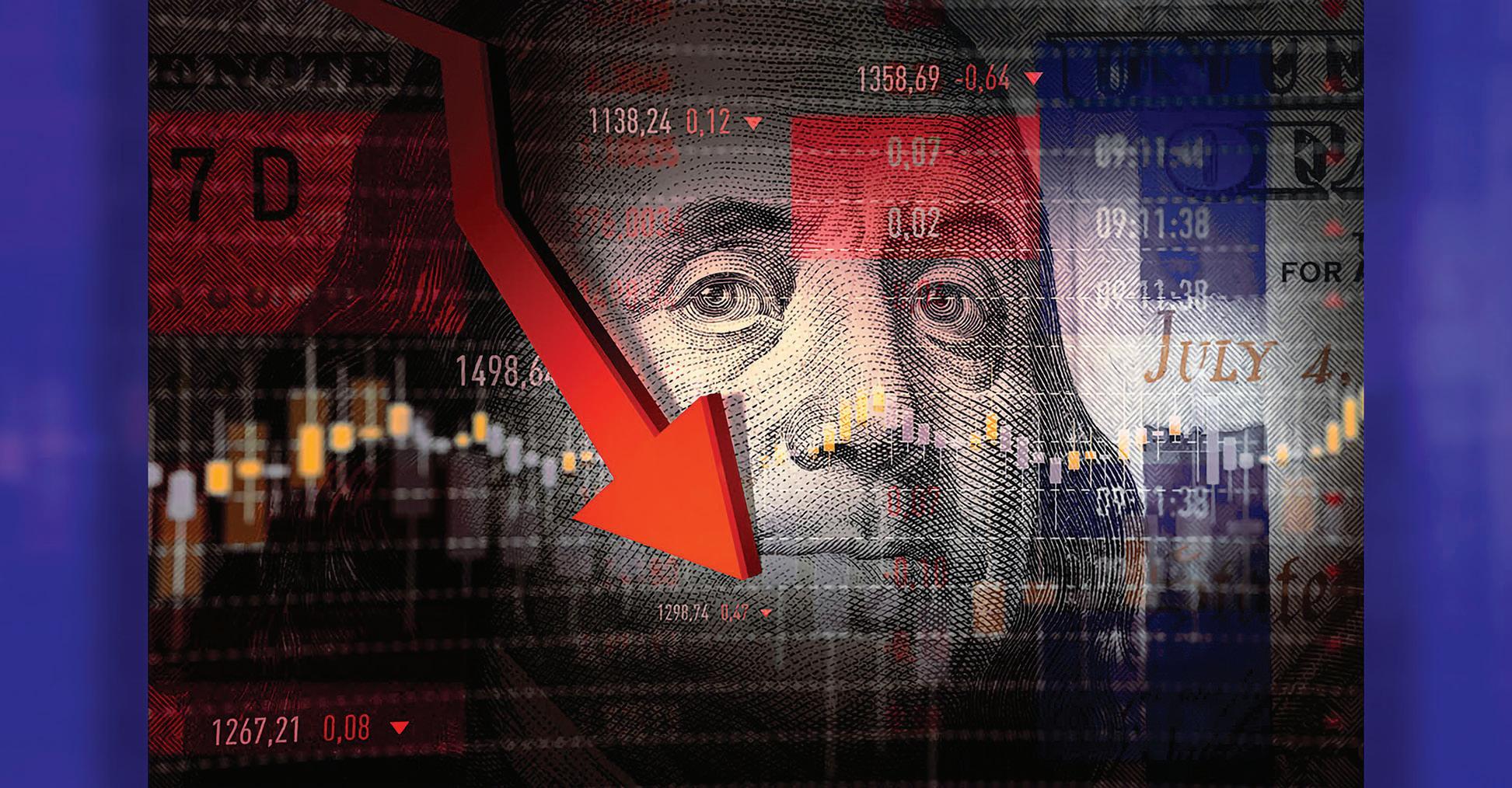
downturns. Additionally, reviewing and adjusting budgets to distinguish between essential and non-essential expenses can help manage finances more effectively. Enhancing skills to remain competitive in the job market is also advised for career security. Prioritizing debt repayment, especially highinterest debt like credit cards, can prevent financial strain during economic downturns. The looming threat of a government shutdown adds another layer of uncertainty. The Black Economic Alliance has expressed concern that such a shutdown could exacerbate racial economic inequality and inflict long-lasting harm on the U.S. economy. They highlight that the prolonged
with their hands.” Think about how commonly that happens—you move the hair over a shoulder, put it behind your ear, or pull it into a bun and then grab a snack.
For braiders—who can work with one client for hours at a time—this might be common, too. If a braider or client touches the hair, they might rub their mouth or grab a quick snack after touching the hair. And finally, there’s putting braids directly in the mouth: “This is not something you see adults doing, but small children who may wear braids tend to put things in their mouth, including hair.”
VOCs in Synthetic Braiding Hair
Ask any hair-braiding client when they know the braiding session is nearly done, and you’ll most likely get the same answer: When the stylist brings out the kettle of hot water, a flat iron, or even a lighter.
The braider dips the braids into the boiling water, as shown below, to bond the synthetic hair to prevent it from unraveling. The braider might also seal the ends using a hot flat iron or a lighter.
While satisfying for both the braider and the client, it’s also dangerous. When the synthetic hair is heated, VOCs are released into the air.
According to the Environmental Protection Agency, VOCs are often human-made chemicals—used to make paints, pharmaceuticals, and refrigerants—that are emitted as gases. The American Lung Association reports that breathing VOCs can irritate the eyes, nose, and throat, cause nausea, and damage the central nervous system, as well as cause cancer in some instances.
CR’s tests showed that VOCs were emitted when the braiding hair was heated to boiling (212° F) in the lab.
The VOC detected at the highest levels for the majority of the hair products was acetone, a respiratory irritant commonly used to dissolve other substances and to produce a wide variety of products.
CR tested for 65 VOCs, and the results revealed that each product contained concerning contaminants:
loss of income poses significant hardships for federal workers, including Black employees from communities still struggling to overcome generations of systemic exclusion from economic opportunity.
The 2020 Ariel-Schwab Black Investor Survey revealed that only 55% of Black Americans reported stock market investments, compared to 71% of white Americans. This disparity results in middleclass Black Americans having less money saved for retirement and less wealth to pass on to future generations. Mellody Hobson, co-CEO and President of Ariel Investments emphasized the urgency of addressing this gap, stating, “Black Americans
“Every sample tested had detectable levels of at least six VOCs. The highest number detected in any of the samples was 14,” Rogers says.
“The higher the total number of VOCs in a product, the higher the likelihood of a negative impact on the health of the user,” Rogers says. “In addition, the presence of one or more suspected or known carcinogens in a product could put the user at a higher risk of exposure to the more toxic VOCs,” such as the carcinogens listed above.
Company Responses CR contacted all the brands for comment about the test results. Only two, Sensationnel and Magic Fingers, responded.
Hair Zone/Sensationnel told Consumer Reports the company was “extremely surprised by the information recently presented to us by Consumer Reports” and strongly disagreed with our methodology and “with the claims Consumer Reports makes about the potential risk to consumers that could arise from the safe and common use of our products.”
They said, “We unequivocally stand by the safety of Sensationnel products, and our company urges consumers to continue to confidently use Sensationnel products.” The company also said, “At Hair Zone/Sensationnel, we pride ourselves on producing the finest quality hair products on the market. As a family-run business with a 35-year history, we value the trust and loyalty of our customers around the world and take the safety of our products seriously. We are constantly evaluating our materials and processes with customer safety in mind.”
Magic Fingers also challenged the test results and methodology, and said that “Magic Fingers is proud of the safe and top-quality hair products we provide to our customers. Our customers know they can count on us for braids and extensions that meet their highest expectations for fashion
Visits to Community Health Clinics Drop as Fears of ICE Raids Escalate...continued from page 4
Because we recognize that public health doesn’t stop by immigratory status. If somebody gets RSV, if somebody gets tuberculosis, if somebody has diabetes and winds up in our emergency rooms, you know, having a heart attack, that has no bearing on immigratory status.
‘Viruses Do Not Understand Immigratory Status’
And we know that the benefits of providing health care to the entire community, regardless of immigratory status, benefits us all. The viruses, bacteria do not understand immigratory status. And so over the last 25plus years, we’ve seen such an advance in the way that we treat people. We went from the PPP to My Health LA, and then finally we ended up with universal access to medical care via state law. All of that is being wiped off in front of our eyes. And so my
are already behind the eight ball, and it is disheartening to see that at current savings and investing rates, the wealth gap will continue to expand, endangering our futures and leaving our families exposed.” Hobson said by staying informed and proactive, Black investors can better navigate the challenges posed by economic downturns and policy changes, working towards financial resilience and stability. “We are resilient people, and so we have proven time and time again … we will fight, and we’ll get creative in our fight,” Seawright asserted. “We’re gonna have to use all those tactics and strategies to not just thrive for the next four years but survive.
and performance.” The company said that CR’s methods “do not fairly match the real-world way that our customers use our Magic Finger products. We strongly stand by the safety of our products and the quality materials used to make them.”
Neither company responded to questions about whether or not they test their products for lead, VOCs, or other contaminants before they go to market.
Rashes While Wearing Braids
One of the most immediate and evident of the adverse effects of synthetic braiding hair presents itself on the skin. “Symptoms include redness, swelling, and rashes on the scalp, neck, or face,” Rogers says, adding that it “occurs when the immune system reacts to allergens present in synthetic hair. It can be associated with any dyes or coloring used in the product.”
This is a complaint commonly heard from braid-wearers, especially right after installation. Dermatologist Chesahna Kindred, MD, says she has had patients who were concerned that they were allergic to their synthetic hair braids. “It would look like contact dermatitis, which is when the scalp is inflamed, it’s red, the patient complained about an itching or burning sensation, and we would have to treat it with a cortisone,” she says.
“This is often attributed to the chemical coatings on the fibers (pesticides, plastics, acrylic, etc.), including those with alkaline bases,” Rogers says. Susan Peterkin, a cosmetologist who works with Kindred, offers this advice: “If you leave the braider and your head is hurting, you need to take them out right away. I try to teach my clients that itching, burning, and any tenderness is not normal.”
It’s not necessarily only the braiding hair that can cause tenderness of the scalp. Some of that could be attributed to the tightness of the braids at the root. Some braiders can go too tight, making it painful for the client, who
biggest fear is that folks are going to go without care. They’re going to show up at emergency rooms, which is the most costly type of health care that you can ever receive.
Costly ER Visits
And so that not only is going to have an impact in the health care and the well-being of our community, but it’s going to be even more costly. I mean, we complain about the amount of money that we currently spend on health care. This has only the potential of making that even worse. And so to me, it’s a sad thing to see that my entire work over the last 24 years advocating for better health care for everybody is being wiped out. But the fight goes on. With our partner clinics, we’ll continue to do what we need to do to support our patients, regardless of their immigration status.
The Thursday E-Edition of The
may request slightly looser braids.
Tight braids—and other hairstyles that pull the hair tightly, such as buns and ponytails, even without the use of added hair—can cause hair loss from traction alopecia, according to the American Academy of Dermatology. Some fortunate braid clients may experience no itching or discomfort when using synthetic braiding hair. CR spoke with braiders and clients at a Brooklyn, N.Y., salon in January, and one of the clients said braids don’t bother her at all.
But it’s not just the scalp that’s at risk, says Tiffany Mayo, MD, an associate professor in the University of Alabama at Birmingham’s department of dermatology and director of the school’s clinical research unit. She says that the skin on the neck can be more sensitive than the skin on the face and that she has seen patients who’ve experienced breakouts on their neck linked to synthetic hair but didn’t have the same symptoms on their scalp.
“Patients are very attached to and sensitive about their hair, so to say ‘absolutely stop this’ is not the best recommendation,” Mayo says.
“There’s a lot of negotiating that has to happen when it comes to hair.”
Mayo’s approach is to first ask patients to remove the braids, if possible. Then she treats the affected areas with a topical steroid. “I treat the actual rash, but counsel that the rash is not going to completely resolve until the exposure has been removed.”
Even after the braids are removed, it’s not always clear whether the irritant was the particular brand of synthetic hair that was used, a product sprayed onto the braids, dyes used to color the braids, or the synthetic fibers used to make the braids. Mayo says reading Thomas’ article also made her wonder about how prevalent hand dermatitis is in braiders themselves as a result of constant occupational exposure.
“There’s no doubt about it that this actually needs a very intensive evaluation because the use is so widespread amongst a specific population,” she says.
Other Potential Health Risks Rashes and redness aside, potential health risks associated with synthetic hair could take years to present themselves.
“We know that they look like endocrine disruptors—they look like things that can mess with our body’s normal hormonal system,” says Tamarra James-Todd, associate professor at the Harvard T.H. Chan School of Public Health and lab director of the school’s Environmental Reproductive Justice Lab. The National Institute of Environmental Health Sciences says that certain endocrine-disrupting chemicals (EDCs), even in low amounts, can negatively affect immunity, metabolism, puberty in humans, and reproduction in mice. James-Todd says that Black women have been found to have much higher concentrations of many of these endocrine-disrupting chemicals. She and her colleagues previously published a review on this subject, and the Silent Spring Institute has used social media to help Black women reduce their exposure to EDCs as part of the Power Study.
“These [chemicals] don’t operate in isolation; they’re operating together,” James-Todd says.
“They’re sitting on your scalp, and with something sitting on your scalp, it can be dermally absorbed. It doesn’t just require heat—it’s sitting around your head, so it can be inhaled. Somebody touches their hair and they eat something, it’s hand-to-mouth, so it can enter the body that way as well.” With so many potential health risks to consider, the choice to get a head full of Fulani braids or cascading goddess locs can start to feel like one big headache. And, thus far, we’ve only been discussing the potentially harmful ingredients that we know about.
Thursday, March 13, 2025 THE SAN BERNARDINO AMERICAN NEWS - COUNTY/WORLD NEWS
Black Homeownership Faces Persistent Barriers Despite Hard-Fought Gains
BLACKPRESSUSA NEWSWIRE — Homeownership remains one of the most significant drivers of wealth, yet Black families face disproportionate barriers to achieving this milestone
By Stacy M. Brown

Happy family standing outside their house
Sonia Reed believed she had achieved the American dream. In December 2024, the Black grandmother and former homeless individual became a homeowner in San Leandro, California. But her triumph quickly turned into a nightmare when neighbors began harassing her with racial slurs and vandalizing her property. “I worked so hard to finally have a place to call my own, and now I have to fear for my safety in my own home,” Reed said.
The Alameda County Sheriff’s Office said it is investigating the incidents as hate crimes.
For many, vandalism is part of an ongoing pattern where Black homeowners have faced some kind of discrimination. Reed’s experience is far from isolated. Black Americans remain locked in a battle for homeownership, confronted by systemic inequities, economic challenges, and, in some cases, environmental disasters that threaten to strip them of generational wealth. A new
Urban Institute report revealed that Black homeownership rates remain far behind those of white Americans. Researchers said it’s a gap rooted in decades of discriminatory housing policies, redlining, and predatory lending practices. “Homeownership remains one of the most significant drivers of wealth, yet Black families face disproportionate barriers to achieving this milestone,” researchers wrote. The crisis extends beyond acts of overt racism. In January 2025, devastating wildfires tore through Altadena, California, a historically Black community with a homeownership rate of 81.5 percent—far higher than the national average. Thousands of homes were reduced to ashes and rubble, leaving families displaced. Many now face the daunting task of rebuilding and the looming threat of gentrification. “Developers are circling like vultures,” said
Black Homeownership Faces Persistent Barriers Despite Hard-Fought Gains...continued
longtime Altadena resident James Carter. “We’re trying to rebuild, but the fear is that we won’t be able to afford to stay.” Economic barriers remain a defining struggle. Brooke Scott, a litigation assistant in Los Angeles, calculated that achieving homeownership and financial security requires an annual household income of $300,000—far beyond what many Black families can attain. Housing costs, healthcare, taxes, and child-rearing expenses leave little room for savings or investment. “The numbers just don’t add up,” Scott said. “Even with two incomes, we’re barely able to put away anything for a down payment.” The Urban Institute’s findings represent a clear picture of the obstacles Black homeowners face. Disparities in income, lending practices, and generational wealth accumulation continue to create barriers that make
Black homeownership an increasingly difficult goal. While federal and local initiatives have sought to close the gap, the road ahead remains steep. “Without significant policy changes and investment in Black communities, the homeownership gap will persist for generations to come,” the Urban Institute report warns. For Reed, Scott, and the residents of Altadena, the challenges of Black homeownership are deeply personal. Whether confronting racial harassment, economic hurdles, or the aftermath of natural disasters, their stories serve as a reminder that the fight for equity in housing is far from over. If these barriers persist, the promise of homeownership will remain an elusive dream for too many Black Americans. “We just want what everyone else has—a fair shot at building a future,” Carter asserted.
Keeping it Real: VA Loma Linda Healthcare System’s Deadly Water and Trump’s Threat of Deadly Cuts
By S.E. Williams

As the VA Loma Linda Healthcare System struggles to grapple with another discovery of Legionella bacteria at various locations within its
facility, President Donald Trump considers cutting 80,000 jobs from the Veteran’s Administration, a move that could have local implications. (Chris Allen, BVN)
across America, we must stayed focused like a laser on impacts to every day life in our community. This is because issues and incidents at the national and local level often overlap.
Take for example what Veterans Affairs Secretary Doug Collins told FOX News Monday about his agency looking to cut 80,000 jobs from the Veterans Administration (VA). He added that the 80,000 jobs is the VA department’s target as a way to to slim the agency’s workforce.
Keeping it Real: VA Loma Linda Healthcare System’s Deadly Water and Trump’s Threat of Deadly Cuts... continued
Whether this actually comes to pass or it is just another example of Trump’s “white noise” is hard to know. However, reports currently indicate layoffs are expected to begin in June.
This may seem like a good idea to Trump supporters but it was just last August that the VA reported it “has been experiencing severe staffing shortages for at least a decade.”
The shortages in fields like as doctors and nurses to nonclinical occupation staffing positions and custodial workers.
“We must ensure that our veterans are given the care and support they so richly deserve. That is our unwavering commitment to those who served under the flag of the United States.”
Meanwhile, last week we learned the VA Loma Linda Healthcare System had ordered precautionary testing for all pneumonia patients following the recent discovery of Legionella bacteria at various locations within its facility. This seems to be a recurring theme at this hospital.
In 2018, a group of whistleblowers, consisting of doctors and nurses, filed a complaint against the medical center claiming it was covering
up a Legionella bacteria outbreak. They further claimed the Legionella was first discovered in 2017, but hospital officials had failed to act to reconcile the issue.
As the Loma Linda VA struggles with this water concern, if the president persists with his course of action there is little doubt projected cuts to staff will most certainly have a local impact. For nearly 50 years this facility has served the region’s veterans, touching at least 76,000 veterans each year. Thinking about the impact of possible job losses at the facility, with nearly nearly 3300 employees, Loma Linda VA is among the top 50 employers in the IE. This nation owes a debt to our veterans and yet it seems they are among the most neglected. For example, 13% of the nation’s homeless are veterans. Our veterans deserve clean water at the facility they go to for healthcare services. They also deserve a fully trained and competent staff at the facility they frequent for healthcare services. Now is the time to pressure our representatives to pressure the president to stop cuts to the VA.
Of course this is just my opinion. I’m keeping it real.
continued in next 2 columns Deadline To Submit Press Releases & Legals Is Mondays By 5pm
In this moment, as President Donald Trump spreads chaos
continued in next 2 columns
URGENT REPORT-Dangerous Chemicals Detected in 100% of Tested Braiding Hair...continued
Challenging
Bhavna Shamasunder, an associate professor at Occidental College in Los Angeles, says incomplete ingredient labeling is a challenge that further complicates matters.
“It is possible some chemicals might not appear on the label,” she adds.
Shamasunder heads the school’s Urban & Environmental Policy and Public Health departments and is a principal investigator in a pilot study called Taking Stock, which explores the health impacts of beauty products on Black and Latina women in California.
She says that the underpinning problem is that the market for such beauty products is largely unregulated, “thus, the issues raised—including exposures to VOCs upon heating synthetic hair . . . and even the ingredients that go into manufacture—are not required to be disclosed.”
Shamasunder is right. CR contacted the Food and Drug Administration and shared our test results. A spokesperson said, in part, that “the FDA cannot comment on the testing results” and that “other federal agencies also may have jurisdiction over hair extension and wig products sold in the United States.” They did not suggest which agencies might have jurisdiction.
The FDA does regulate cosmetic products under the Federal Food, Drug, and Cosmetic Act, which states, in part:
“The term ‘cosmetic’ means (1) articles intended to be rubbed, poured, sprinkled, or sprayed on, introduced into, or otherwise applied to the human body or any part thereof for cleansing, beautifying, promoting attractiveness, or altering the appearance, and (2) articles intended for use as a component of any such articles; except that such term shall not include soap.”
In searching the FDA Hair Products page, there is no indication that braiding hair has ever been reported as being unsafe, nor have there been any recalls. It appears that this regulatory agency does not presently have specific information on braiding hair products and adverse or harmful reactions.
“It’s appalling that toxic chemicals are in these products with
so little scrutiny from those who are supposed to protect people, like the FDA,” says Oriene Shin, manager of safety advocacy for Consumer Reports. “Consumers should never have to risk their health when choosing personal care products, and yet, harmful ingredients in products marketed to Black women continue to go unaddressed. This inaction has failed Black women for too long, and policymakers should take the steps necessary to address these gaps and hold companies accountable when they put consumers at risk.”
Shamasunder summarized the conundrum by saying:
“Unfortunately, without systematic chemical policy reform, where safe ingredients are required in product manufacture, the burden is on scientists, advocates, and consumers in an often slow and onerous product-by-product approach.”
CR also contacted the Personal Care Products Council, a national trade association that represents hundreds of global cosmetics and personal care products companies, to find out whether there are any industry standards for manufacturing or ingredients. Their spokesperson said, “PCPC does not represent the synthetic braiding industry, so we cannot provide commentary.”
So how are consumers supposed to know how to safely maneuver their way down the synthetic hair aisles? Should they just avoid using synthetic braiding hair altogether?
Janice Smith, CR’s senior content impact and outreach associate, expressed concerns about the safety and potential benefits of other products made with synthetic hair.
“I just wondered about braided wigs that are now becoming popular as folks don’t like sitting for hours to get their hair braided,” she says. Those wigs, along with ponytails, can be removed daily if the wearer prefers that. All important questions.
“The simple answer is that it’s not simple,” says Christina Chapman, a radiation oncologist and assistant professor at Baylor College of Medicine who researches and writes about racial and gender equity in healthcare.
Acrylonitrile, an ingredient used to manufacture at least one synthetic braiding hair, for instance, can be harmful to the eyes, skin, lungs,
and nervous system, and may cause cancer, according to the Centers for Disease Control and Prevention. Both the EPA and the Department of Toxic Substances Control have classified it as a probable human carcinogen.
The DTSC and the EPA list vinyl chloride, another ingredient used to make at least one synthetic hair product, as carcinogenic. And, according to the National Cancer Institute, vinyl chloride exposure is associated with an increased risk of brain and lung cancers, lymphoma, and leukemia.
Despite all the products having harmful chemicals present, CR braiding hair test leader Rogers says these test results prove that companies can do a better job of creating safer products. “Some products had lower concentrations of VOCs, and at least one tested negative for heavy metals, including lead—a known carcinogen. This demonstrates that healthier products are possible, including products made without lead and with fewer VOCs,” he says.
The Effects of Racism Need to Be Studied
Chapman argues that a major limiting factor in studies about the carcinogenic effects of Black women’s beauty products is that the studies don’t consider what she says is a major contributor to some cancers—stress from experiencing systemic anti-Black racism.
A 2022 study found that chronically stressful conditions such as racism have a direct impact on the cellular mechanisms that drive lethal, invasive forms of breast cancer.
“Let’s say there are carcinogenic materials in hair straighteners or in synthetic hair,” Chapman says. “Even if you completely remove those, that doesn’t solve the problem of anti-Black racism. Even if you develop hair products or hair straighteners that aren’t detrimental with respect to the chemicals in them, the fact is, you still have a system of anti-Black racism.”
“The scientific community,” she continued, “needs to perform higher-quality studies that measure racism more directly, so that we can determine whether it’s really the chemicals in the hair, or whether
it’s the racism itself.”
What You Can Do Rogers recommends that before buying and using a new pack of synthetic braiding hair, shoppers should:
Check for recalls. MedWatch is a good starting point (while our recent search didn’t reveal any recalls, they would be posted here). Consumers should also consult the manufacturers’ websites to see if there is additional information on the product.
Read product labels carefully. There could be important information on ingredients that could cause allergic or other adverse reactions.
Report adverse effects. If there are any adverse reactions when using braiding hair, consumers should report the issue(s) to their healthcare provider, and to the FDA (via MedWatch).
James-Todd, the lab director of Harvard’s Environmental Reproductive Justice Lab, says her approach is to err on the side of caution. “People say, ‘Well, there’s chemicals everywhere; I don’t care.’
But there are some things that are safer than other things,” she says.
“People need to be a little more cognizant about what they may be exposing themselves and their kids to.”
Social media mavens on TikTok and YouTube swear by the trick of prerinsing with apple cider vinegar before installing synthetic braiding hair in order to “wash away” ingredients that may cause itching. Although it’s a commonly shared remedy, Silent Spring Institute scientist Elissia Franklin, PhD, who is leading a study on synthetic and natural hair, says there is currently no scientific evidence that rinsing is effective at reducing exposure to harmful chemicals. Cheryl Burgess, MD, of the Center for Dermatology in Washington, D.C., clarifies that soaking the synthetic hair in apple cider vinegar may make it silkier and less hard and bristly. However, she says, “Rinsing is not a cureall. You still can be irritated by the polyvinyl, the nylon, or whatever is being used.” If you do choose to go the prerinsing route, Burgess also advises using caution: “You
could potentially release harmful chemicals,” she says. “That’s why you’re not supposed to do it at 100 percent concentration. It should be a dilution of 2:1 water.”
Franklin recommends choosing to buy hair products with claims of using only nontoxic ingredients, but, she warns, “because the products do not need to be tested for these claims before they are put on the market, companies can make those claims without regulation.”
“For the most part,” she says, “relative to other products, those might be the better option for folks interested in being more conscientious consumers.”
An internet search for “nontoxic synthetic braiding hair” generates a list of brands that claim to be antiitch, antibacterial, organic, and even biodegradable. “Plant-based” is also a recurring buzzword, as with such brands as Lillian Augusta Beauty, Nourie, and Róun Beauty. Rebundle, a line of braiding hair that lists banana fiber as its main ingredient, states that its products contain no polyvinyl chloride or phthalates.
A group of chemical compounds often used as plasticizers, phthalates have been identified as endocrine disruptors. EZbraid also states that its brand is free of phthalates. (CR did not test these brands but is considering future tests of products labeled as nontoxic.)
Even with companies that make “nontoxic” claims, many of the manufacturer sites omit ingredients lists. As the Campaign for Safe Cosmetics, a program of Breast Cancer Prevention Partners (BCPP), says: “There are no legal standards for personal care products that are labeled ‘clean,’ ‘pure,’ ‘natural,’ or ‘organic.’” So, braid lovers attempting to do their due diligence can still find themselves tied up in knots.
“It’s unfair for the consumer to have to be the one to have to figure out,” says Kindred, the dermatologist. “That onus should fall on us, the medical professionals and the stylists.”
But she has found a ray of positivity amid all of these seemingly bleak beauty prospects.
She says the expansion of a cosmetic chemistry science program at Spelman College in Atlanta is
a program that gives her hope for the future.
“We’ll have a whole cadre of Black women that will be equipped to take this on,” Kindred says. Likewise, James-Todd is optimistic about the rollout of a Department of Health and Human Services competition that awards innovators who are aiming to reduce EDC exposure risks for Black women. Phase 1 winners, according to a 2023 HHS press release, included Black Women for Wellness, which provides healthy hair information to Black communities in Los Angeles; Hackensack University Medical Center, which is creating an educational training program focused on racial/ethnic disparities related to salon products for hair professionals working in New Jersey’s salons; and Emily Hilz, a researcher in Austin, Texas, who is developing an app to help consumers reduce exposure to EDCs. Franklin also led a team that was a winner in phases 1 and 2; she is working on phase 3 now.
“Hopefully, as we become not only more aware, but the workforce becomes more diverse, we’ll be able to know more in order to advise better,” James-Todd says. In the meantime, she recommends reducing the use of synthetic braiding hair to short-term rather than constant wear. Thomas, the Albert Einstein student who turned her personal experience with these products into compelling professional research, echoes that sentiment: “While there has not yet been research to define the actual extent of risk of synthetic braids, one thing stylists and healthcare providers can do now is advise against immediately reinstalling a new set of braids after four to six weeks, to lessen overall exposure.”
Leigh-Ann Jackson is a freelance writer based in Los Angeles who has covered arts and entertainment, style, consumer goods, and pop culture for 25 years. Her work has appeared in print and online at publications such as the New York Times, Los Angeles Times, Buy Side, Texas Monthly, Bon Appétit, the Hollywood
Thursday, March 13, 2025
How Will DEI Bans Affect U.S. Small Businesses?
By Selen Ozturk
Since Trump’s termination of federal diversity, equity and inclusion (DEI) initiatives, small businesses nationwide are expected to take a major hit.

Since Trump’s termination of federal diversity, equity and inclusion (DEI) initiatives, small businesses nationwide are expected to take a major hit.
The executive orders issued during Trump’s first week of office in late January end all federal DEI and affirmative action programs; equity-related grants and contracts; and prior equal opportunity executive orders.
The directives come mainly from a trio titled “Ending Illegal Discrimination and Restoring Merit-Based Opportunity,”
“Ending Radical and Wasteful Government DEI Programs and Preferencing” and “Defending Women from Gender Ideology Extremism and Restoring Biological Truth to the Federal Government.”
There are 33.2 million small businesses in the U.S., comprising 99.9% of all businesses.
Over 40% of small business owners are women, 24% are immigrants, and nearly one in five are racial minorities, with Latinos comprising a major portion of that group.
“The attack on so-called DEI is really an attack on American entrepreneurship, and this is just the start,” said Dilawar Syed, former deputy administrator of the Small Business Administration (SBA), at a Friday March 7 Ethnic Media Services briefing about impacts on small businesses. “The fastest growing segment
of entrepreneurs in our country are people of color … with an absolutely historic number of veterans as well.”
The executive orders accompany a January 27 funding freeze of hundreds of billions of dollars for federal programs, and February federal layoffs under the Elon Musk-led Department of Governmental Efficiency including 20% of SBA staff, approximately 720 employees.
“We all want to see better efficiency, but this approach of laying off 20% of the workforce — many of whom are people providing customer service — without even stepping a foot in these agencies, is just inefficient,” said Syed. “Now you have even longer wait times to get help. It would affect every single American who wants to start or grow a business.”
Last Thursday, SBA Administrator Kelly Koeffler also announced that the agency would close offices in six major cities — including Chicago, Denver and New Orleans — due to sanctuary city laws.
“That doesn’t help us serve this unmet need of a rising class of entrepreneurs of color,” said Sayed. “American economic competitiveness in the world is directly tied to immigrants pursuing their dreams.”
In 2024, 46% of Fortune 500 companies, or 230 companies, were founded by immigrants or their children.
“We have to uphold our
country’s laws, but we’re not talking about reforming proper legal pathways for people to become productive citizens,” added Sayed. “All we’re doing is choking a very important source of labor in this country by demonizing immigrants.”
These SBA rollbacks — alongside a reduction of the agency’s diversity funding quota from 15% to 5% across contracts — mean steeper hurdles for small businesses trying to get SBA approval, which is crucial to bidding on federal contracts.
“I’m concerned that the very programs we were bidding on will be eliminated now,” said Elizabeth Barrutia, president and CEO, Barú, a multicultural marketing agency she founded in Los Angeles 17 years ago.
“There’s a trickle-down effect into the whole media landscape I work with,” she continued.
“When minority outlets — print, broadcast, television — are getting less dollars to market government programs like health, education or financial aid services … there will be long-term disproportionate outcomes for health equity, educational attainment and financial attainment.
“Innovation will falter, and innovation is what generates more dollars,” Barrutia added.
“Years ago, they would say multicultural marketing is good for business. Now I’m wondering whether they understood it was a business imperative to begin
with.”
Multicultural U.S.consumer spending rose from $458 billion in 1990 to $3.2 trillion in 2021.
In 2023, multicultural media spending grew by 5.7% over the past year to $34.64 billion, comprising 5.3% of total U.S. ad buying.
“These efforts under the banner of DEI rose up in order to stop discrimination that was ongoing and widespread in favor of white men … and to ensure that that discrimination is replaced by policies that ensure that people of color and women receive a fair shake in competing for employment or contracts,” said Thomas A. Saenz, president and general counsel of theMexican American Legal Defense and Education Fund.
“This administration’s attack on dei is about making it easier for those who are inclined to engage in that discrimination in favor of white men, and intimidate those who are interested in taking steps to end that discrimination,” he added.”
“We’re creating this scarcity mindset of ‘If I give other people opportunities, then you’re taking away from me,’” said Dr. Esther Zeledon, founder of Be.Act.Change, a life coaching organization. “In my own case, I lost 95% of my contracts across sectors, from human rights to climate science … I have a PhD in environmental science from Berkeley, and people no longer trust my work.”
“The language of the executive orders — that all DEI efforts are wasteful and radical — politicizes and puts mistrust onto people who have benefited from those programs,” she continued.
“It’s not just changing a policy, it’s saying that we don’t have any wrong to correct.”
“Because it’s an attack on social mobility, it’s an economic attack on all of us who are seeing a rise in oligarchy in our leadership,” Zeledon added.
“We need to open doors for each other if we want to help America be stronger, better, more prosperous.”
California Surgeon General’s Office Launches New Tool to Lower Maternal Mortality Rates

The California Surgeon General’s Office has launched a new questionnaire that they believe will help reduce the state’s maternal mortality rate by 50% by December 2026 as part of its Strong Start and Beyond movement.
The Preconception Medical Assessment or PreMA is comprised of eight yes or no questions that can help potential mothers understand how their current health status and history affect a future pregnancy. The Office plans to provide digital links and physical PDFs of the questionnaire and distribute them among women living in communities designated as “high risk.”
“We know that over 85% of maternal deaths in California can be prevented,” said California Surgeon General Dr. Diana
Ramos during an Office of Community Partnerships and Strategic Communications (OCPSC) digital press conference.
“Moms don’t have to die. Our sisters, our mothers, the wives, they don’t have to die. We can save their lives by simply alerting people to the fact that their current health could impact the pregnancy and postpartum.”
Question topics include heart health, high blood pressure, diabetes, respiratory issues, drug use and history of surgery.
Once a woman answers the questions, there are general recommendations for care at the bottom of the questionnaire based on the number of ‘yes’ responses they give. Also, at the bottom of the quiz, there are links to resources where people can get information on medical
care, housing and other programs providing aid to new mothers.
Additionally, 62% of maternal deaths occur after the baby has been delivered. PreMA can also be affective to monitor health conditions between pregnancies as well to help lower this number.
“There were so many times when I cared for patients and I had to tell them, ‘you’re going to be needing more medical care, or you’re a higher risk pregnancy because of the chronic medical condition that was present before you became pregnant.’ And inevitably, the words that always came out of the people that I cared for was, ‘I wish I would have known. I wish I would have known that there was something that I could have done to improve the outlook for my pregnancy.’”
Black women in the U. S. are more than twice as likely as white women to die due to complications related to maternity and the birthing process, according to the Centers for Disease Control and Prevention (CDC).
For Black women in California, the risk of death due to pregnancy complications is four to six times higher than any other ethnic group, according to data from the California Health Care Foundation.

Bloomington’s Field of Dreams Becomes Reality:
$3.3M Investment Brings State-of-theArt Ballpark to Underserved Community
What: San Bernardino County Supervisor Joe Baca, Jr., along with local officials and community leaders, will host the ribbon-cutting ceremony for Kessler Dream Field, a $3.3 million state-of-the-art baseball field in Bloomington. This field will serve as the new home for Bloomington Little League, providing young athletes with a high-quality space to play and grow.
The event will feature appearances by former Los Angeles Dodgers players Lee Lacy and Steve Garvey, who will be providing words of encouragement to celebrate this milestone for the Bloomington community.
Licensed Doula Ithiopia McKinney is an example of one of those women. McKinney, said at the time of her pregnancy she did not qualify for insurance. According to McKinney, she had to utilize the services of an emergency room. During a visit she found out that there was a bleeding from her placenta caused by high blood pressure.
“If it was something that was caught beforehand, I would have been able to take the necessary steps to fix it with medical care,” said McKinney. “And I would not have had anxiety during my pregnancy. They were even talking about it might be possible that I had to stay in the hospital. I was put on bed rest, but I really couldn’t be on bed rest because I was an immigrant trying to work.”
A Black immigrant, McKinney’s struggles are common for women of color in the United States.
Black women in California experience pregnancy-related maternal mortality rates that are three to four times higher than other women.
“A tool like PreMA would give us the information that we would need before we even think about
When: Friday, March 14, 2025 at 6 PM Where: Kessler Park, 18401 Jurupa Ave, Bloomington, CA Visuals & Interview Opportunities:
*Supervisor Joe Baca, Jr., Vice Chair, San Bernardino County Board of Supervisors
*Assemblymember Robert Garcia
*Bloomington Little League Athletes & Families
*San Bernardino County Officials & Community Leaders Event Logistics Parking available onsite.
Assemblymember Robert Garcia will throw the first pitch and deliver remarks highlighting the importance of this investment in youth sports and community development.
California Surgeon General’s Office Launches New Tool to Lower Maternal Mortality Rates...continued getting pregnant. Every time you empower a woman, and in terms of their reproductive health, it leads to better outcomes. And so that is one of the reasons why me personally, we started the mobile health planning. No woman would not have that prenatal care that I, unfortunately, had.”
• Come Join our Victorville Senior Citizens Club $50 per calendars year
• Bingo March 8th & 25th @ 11am, doors open 10:15am. Buy in $25. Bingo held on 2nd & 4h Saturday of each month.
• AARP Tax Preparation: March 5, on every Wednesday and no appointment, free
• Bunco: March 14 Friday 1pm-5pm, $12, Lite refreshment
• Inland Counties Legal Services : March 19, on the 3rd Wednesday of every other month. free By Appointment only 800-977-4257 or 951-368-2551.
• Activities: chair & moderate exercise, card games, pool, line dancing & soul line dancing and community garden Meals on Wheel 11:30am-12:30 14874 S. Mojave Av, Victorville CA 92395, 760-245-5018
Edward Henderson | California Black Media
